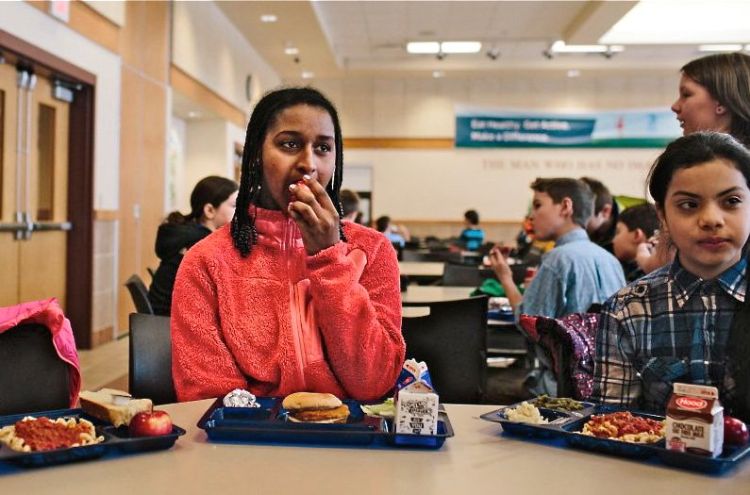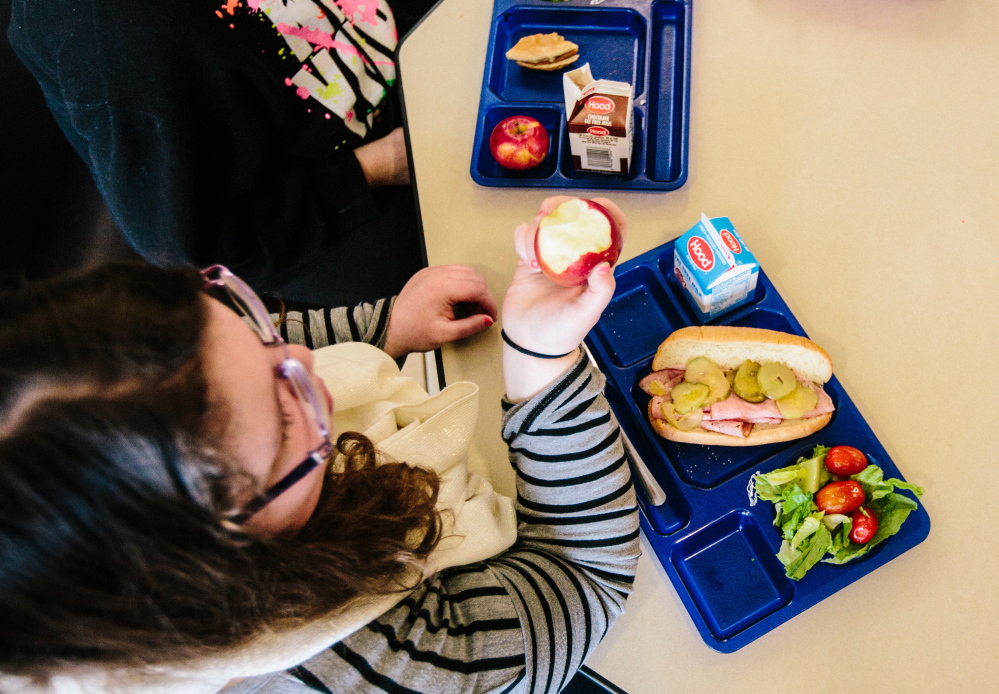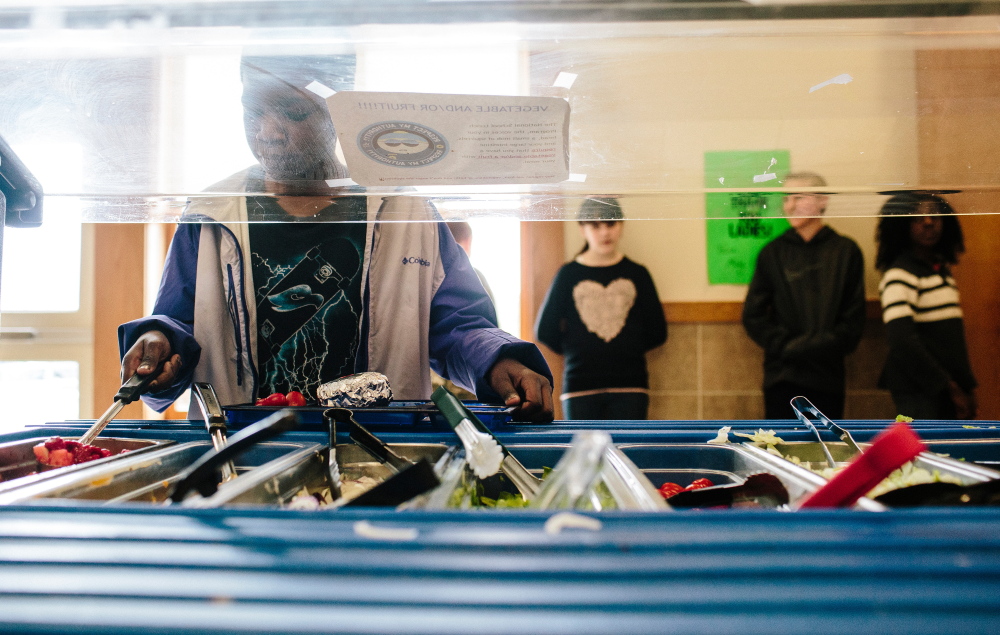Westbrook Middle School students piled their food trays high with whole wheat pasta covered in fresh sauce, homemade bread, snap peas, ruby red tomatoes and pineapple – with no brownies, french fries or other junk food in sight. The students joked and gossiped like middle school students will, and seemed happy at the bounty of healthy food choices before them.
More than half of those going through the line willingly dug into the salad bar.
Maine appears to be on the cutting edge among the 50 states in improving the nutrition of its public school lunches, specialists say.
The typical school lunch in Maine is more nutritious than the national average, according to U.S. Department of Agriculture reports and statistics kept by the Maine-based Let’s Go! program, which coordinates and advocates for better nutrition in school lunches.
Cafeterias across Maine are waving goodbye to the institutional food of yesteryear, shunning greasy mystery meat, instant mashed potatoes and hard-as-rock cookies.
If it’s done right, the students accept and, in some cases, applaud the changes.
“It’s better than the food at home!” said Dima Ali, 10, a Westbrook Middle School fifth-grader, as her friends giggled and nodded in agreement.
“Those deep fryers, they’ve been removed,” said Heidi Kessler, senior program manager for Let’s Go! “When french fries are served, they’re now baked, not fried.”
What in “Taco Tuesday” is going on?
One incentive has been federal school lunch standards, which have become increasingly strict. Empty calories are out, and new mandates push school cafeterias to serve healthy food. Whole wheat, dark green vegetables and fruit are more and more on school menus.
Unlike most states, Maine enjoys a robust effort to improve the nutrition in school lunches, experts say, with the Let’s Go! program leading the charge.
The campaign encourages cafeterias to prepare meals above minimum federal standards. The state is broken up into “regional work groups” where food service managers get together monthly with Let’s Go! employees to brainstorm ideas. Let’s Go! is a partnership of several organizations, including MaineHealth, the parent company of Maine Medical Center; Harvard Pilgrim Health Care; Hannaford Supermarkets; and United Way of Greater Portland. Let’s Go! started in 2006, and uses its $1.2 million annual budget on a number of programs, including improving school lunches and increasing physical activity in schools.
PROGRAM LOOKS TO ADD SCHOOLS
So far about 93,000 schoolchildren, more than half the total public school population in Maine, are eating Let’s Go! lunches that exceed federal nutrition standards. Compared with the national average, Maine has more than triple the percentage of schools that have achieved a “U.S. Healthier Schools” designation – meaning schools that served meals well above the federal nutrition minimums.
Kessler said Let’s Go! will launch an outreach effort this spring to bring more schools into the fold, particularly in the Bangor and Augusta areas, with the goal of becoming statewide within a few years.
“We want to have a presence in every region in the state,” she said.
At Westbrook’s schools, food service director Barbara Nichols works closely with lunchroom manager Sally Hume to devise a menu that students will like.
“I stand over by the garbage line and look at what students are throwing out,” Nichols said. “If they’re throwing something out too much, we won’t serve it again.”
Hume said they pay attention to the increasing diversity at Westbrook, and will serve some ethnic food, such as falafel and tabouli.
“Most of what we make is from scratch,” Hume said. “We want to hear from the students.”
Nichols said they used to waste time packaging individual portions of institutional food, but now use the time to make homemade recipes. She said they make the food from scratch with the same number of employees.
Several fifth-grade students at Westbrook Middle School gave the food an enthusiastic “thumbs up.”
“We appreciate it, and we like it. It tastes better, it’s healthier and we get to choose what we like,” said Brady McKeough, 10.
“Delicious,” said Aby Erazo-Paz, 12, without a hint of sarcasm.
The ingredients to improving school lunches are similar to building a successful grass-roots effort, with a lot of encouragement, organization, incentives and ideas that come from the schools themselves. Those ideas are shared and then rolled out among the various schools. Let’s Go! also offers nutrition training for schools.
“Every idea that we’ve gotten has come from the schools. We want to build on the successes that they already have,” Kessler said. “We’re not sitting in an office dreaming up ways to be the food police.”
In Westbrook, Nichols said the group meetings with other Cumberland County schools have been invaluable. Participants share ideas on how to up the ante, serving nutritious food that the students will eat.
“I got a great chicken cacciatore recipe from them, and I wouldn’t have thought to put it on the menu otherwise,” Nichols said.
STRATEGIC PLACEMENT OF CHOICES
The idea is to make the healthy food appetizing, Kessler said, but also present it in a way that encourages students to choose it.
“It does us no good if we serve them lunch and the kids never pick it up or throw it away,” she said.
It’s food psychology, similar to how a grocery store strategically places items to maximize profit. Chocolate milk is put behind the white milk, and chips are moved away from the most common sight lines.
“Instead of putting candy next to the checkout, put a well-lit fruit bowl next to the checkout,” Kessler said.
Cornell University has studied this phenomenon, starting The Cornell Center for Behavioral Economics in Child Nutrition Programs. Let’s Go! is sending Cornell’s Smarter Lunchrooms survey to all public schools in Maine this spring – to see whether they are employing the techniques, and also to encourage those that haven’t to join Let’s Go!
Simply placing food in the right areas, in an attractive way, greatly increases students’ willingness to choose the healthy food, research shows. Calling the food an irreverent name such as “X-ray carrots” “protein power chick peas” or “cheesy-squeezy burritos” will also help students pick them up.
“We have to remember to design lunches for the kids,” said Brian Wansink, professor of marketing at Cornell who co-founded the university’s Smarter Lunchrooms movement. “We don’t want to design adult foods for an adult palate.”
But Wansink said school cafeterias should also be careful not to make changes that would cause students to rebel. He said he’s seen some schools where more than 75 percent of the students now bring packed lunches because of heavy-handed, poor implementation of federal nutrition standards.
“When schools take away the chocolate milk, nothing really good happens,” Wansink said. “These are kids, and they should be allowed to enjoy indulgences, just like we do.”
Wansink said the key is to encourage healthy behavior, and that will help students make good choices. He said a bad outcome would be if more students packed lunches and brought in more junk food to the school.
Meanwhile, dessert at many Maine schools has become a “sometimes” treat, rather than an everyday occurrence, Kessler said. When dessert is served, it’s often a whole-grain cookie or a low-sugar fruit cobbler.
HIGHER COST, SOME RESISTANCE
Some changes to school lunch programs cost nothing or very little to implement, such as placing the fruit bowl by the checkout line. But it does cost more to serve healthy lunches.
The USDA’s National School Lunch Program reimburses schools an additional 6 cents per meal to comply with its new nutrition standards, but it costs 10 to 34 cents per meal to implement them, Kessler said. For a typical Maine elementary school, the cost to make the changes is less than $10,000 per year.
The federal changes to minimum nutrition standards have caused some resistance, and Congress is considering rolling back the nutrition requirements. Kessler lobbied against weakening the standards while visiting Washington in February.
She said the pushback has happened at schools that have not embraced the new federal standards and have not figured out a way to make healthy food appetizing for children.
For instance, if you have pizza day, make pizza with whole wheat crust, low-fat cheese and vegetable toppings. The kids still eat the pizza, Kessler said.
“Parents, give school lunch a second chance. It’s not what you remember,” she said.
Send questions/comments to the editors.





